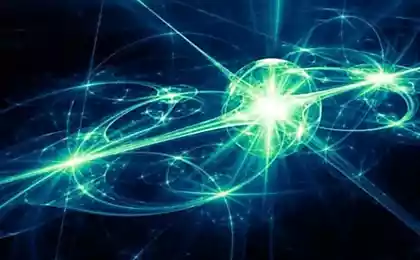422
Scientists have proved the ability to control people by the power of thought
Fifty six million eighty nine thousand six hundred fifty nine
In a recent scientific journal PLOS ONE describes the details of a series of experiments in which scientists were able to realize remote connection of the brain between people and force one group of people solely by the power of thought to control the actions of another group of people. To make it clearer, imagine that beside you is a man and you are only one force of his thoughts could make him, say, to scratch his nose. Sounds cool, isn't it?
For the experiment, scientists from the University of Washington collected six volunteers who were divided into three groups. One person from each group was connected to electroencephalogram, which followed the condition of their brain activity, at the moment when they at the request of scientists playing a computer game. Another member of the group wore on his head a cap with a magnetic stimulation coil. When a person is in electroencephalogra started to think about the movement of his hands, to shoot the game from the cannon, the system has caught a special brain signals and sent them to another person of this group on the Internet. The magnetic coil on the helmet took these signals and stimulated the human brain to the arm movement. As a result, people moved the hand, though they do to do not going.
It is important to note that participating in this experiment people were in different buildings. That is, between the brain of people about a kilometer away from each other and unable directly to each other to interact, scientists have been able actually to create a direct connection.
As it surprisingly sounds, but such experiments are not the first of its kind. In February 2013, scientists at the brain level has created a link between two lab rats. More specifically, one of these rodents, while in North Carolina (USA), was able to control the behavior of other rats, who was at that time in Brazil.
Moreover, in August 2013, the same experts from the University of Washington behind the latest study brain communication for the first time could make one man to control the hand motion of another person. Then the scientists did not call for volunteers and decided to try this method for yourself.
Commenting on the success of these experiments with the involvement of outside volunteers, Andrea Stocco, one of the authors of the study, says:
"A new study of our interface brain-brain lets go of the paradigms and theories are closer to the actual creation of technology. We were able to realize and to repeat the success of past experiences and now know that this method works on other people."
Scientists from the University of Washington explain that he would like to continue research in this direction and move to the possibility of transmission between the brain more complex information. In other words, the researchers plan to find a way to transfer between people (or rather their brain) of visual information and phenomena of a psychological nature — rules and concepts — without installing the actual interaction between people for communication.
Scientists believe that through such research study will be much easier and faster as new information and knowledge, teachers will be able to transmit to its students by creating between them a direct brain connection.
"Imagine an outstanding scientist, but a hopeless teacher. Complex knowledge is very difficult to explain, since we are restricted to linguistic features. The interface of the brain, the brain will allow us to overcome this barrier."
Source: hi-news.ru
In a recent scientific journal PLOS ONE describes the details of a series of experiments in which scientists were able to realize remote connection of the brain between people and force one group of people solely by the power of thought to control the actions of another group of people. To make it clearer, imagine that beside you is a man and you are only one force of his thoughts could make him, say, to scratch his nose. Sounds cool, isn't it?
For the experiment, scientists from the University of Washington collected six volunteers who were divided into three groups. One person from each group was connected to electroencephalogram, which followed the condition of their brain activity, at the moment when they at the request of scientists playing a computer game. Another member of the group wore on his head a cap with a magnetic stimulation coil. When a person is in electroencephalogra started to think about the movement of his hands, to shoot the game from the cannon, the system has caught a special brain signals and sent them to another person of this group on the Internet. The magnetic coil on the helmet took these signals and stimulated the human brain to the arm movement. As a result, people moved the hand, though they do to do not going.
It is important to note that participating in this experiment people were in different buildings. That is, between the brain of people about a kilometer away from each other and unable directly to each other to interact, scientists have been able actually to create a direct connection.
As it surprisingly sounds, but such experiments are not the first of its kind. In February 2013, scientists at the brain level has created a link between two lab rats. More specifically, one of these rodents, while in North Carolina (USA), was able to control the behavior of other rats, who was at that time in Brazil.
Moreover, in August 2013, the same experts from the University of Washington behind the latest study brain communication for the first time could make one man to control the hand motion of another person. Then the scientists did not call for volunteers and decided to try this method for yourself.
Commenting on the success of these experiments with the involvement of outside volunteers, Andrea Stocco, one of the authors of the study, says:
"A new study of our interface brain-brain lets go of the paradigms and theories are closer to the actual creation of technology. We were able to realize and to repeat the success of past experiences and now know that this method works on other people."
Scientists from the University of Washington explain that he would like to continue research in this direction and move to the possibility of transmission between the brain more complex information. In other words, the researchers plan to find a way to transfer between people (or rather their brain) of visual information and phenomena of a psychological nature — rules and concepts — without installing the actual interaction between people for communication.
Scientists believe that through such research study will be much easier and faster as new information and knowledge, teachers will be able to transmit to its students by creating between them a direct brain connection.
"Imagine an outstanding scientist, but a hopeless teacher. Complex knowledge is very difficult to explain, since we are restricted to linguistic features. The interface of the brain, the brain will allow us to overcome this barrier."
Source: hi-news.ru























